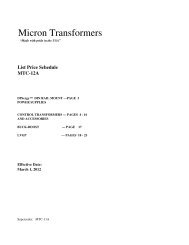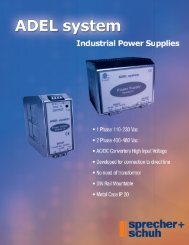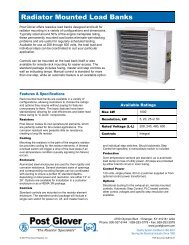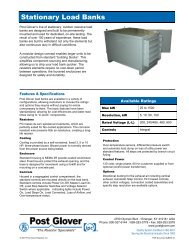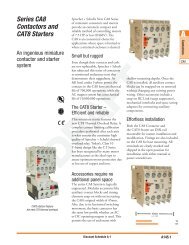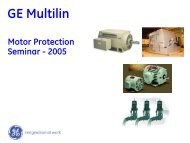Catalog CCT-10A
Catalog CCT-10A
Catalog CCT-10A
Create successful ePaper yourself
Turn your PDF publications into a flip-book with our unique Google optimized e-Paper software.
TRANSFORMER SELECTION PROCESS<br />
Determining Inrush and Voltage Requirements<br />
Selecting a transformer for industrial control<br />
circuit applications requires knowledge of the<br />
following terms:<br />
INRUSH VA is the product of the load voltage<br />
(V) multiplied by the current (A) that is<br />
required during start-up. It is calculated by<br />
adding the inrush VA requirements of all<br />
devices (contactors, timers, relays, pilot lights,<br />
solenoids, etc.), which will be energized<br />
together. Inrush VA requirements are best<br />
obtained from the component manufacturer.<br />
SEALED VA also called Steady State VA, is<br />
the product of the load voltage (V) multiplied<br />
by the current (A) that is required to operate the<br />
circuit after initial start-up or under normal<br />
operating conditions. It is calculated by adding<br />
the sealed VA requirements of all electrical<br />
components of the circuit that will be energized<br />
at any given time. Sealed VA requirements are<br />
best obtained from the component<br />
manufacturer.<br />
PRIMARY VOLTAGE is the voltage<br />
available from the electrical distribution system<br />
and its operational frequency, which is<br />
connected to the transformer supply voltage (H)<br />
terminals.<br />
SECONDARY VOLTAGE is the voltage<br />
required for load operation, which is connected<br />
to the transformer load voltage (X) terminals.<br />
1. Determine the Application Inrush VA<br />
by using the following industry<br />
accepted formula.<br />
Application Inrush VA = √ (INRUSH VA)² + (SEALED VA)²<br />
2. Refer to the Regulation Data Chart. If<br />
the primary voltage is basically stable<br />
and does not vary by more than 5%<br />
from nominal, the 90% secondary<br />
voltage column should be used. If the<br />
primary voltage varies between 5 and<br />
10%, the 95% secondary voltage<br />
column should be used.<br />
3. After determining the proper secondary<br />
voltage column, read down until a value<br />
equal to or greater than the Application<br />
Inrush VA is found. In no case should a<br />
lesser figure be used.<br />
4. Read left to the Transformer VA Rating<br />
column to determine the proper<br />
transformer for the application. As a<br />
final check, make sure that the<br />
Transformer VA Rating is equal to or<br />
greater than the total sealed VA<br />
requirements.<br />
5. Refer to the catalog pages to determine<br />
the proper catalog number based on the<br />
transformer VA and primary and<br />
secondary voltage requirements.<br />
Once the circuit variables have been<br />
determined, transformer selection is a simple<br />
5-step process as follows:<br />
4 MICRON POWER DELIVERY




